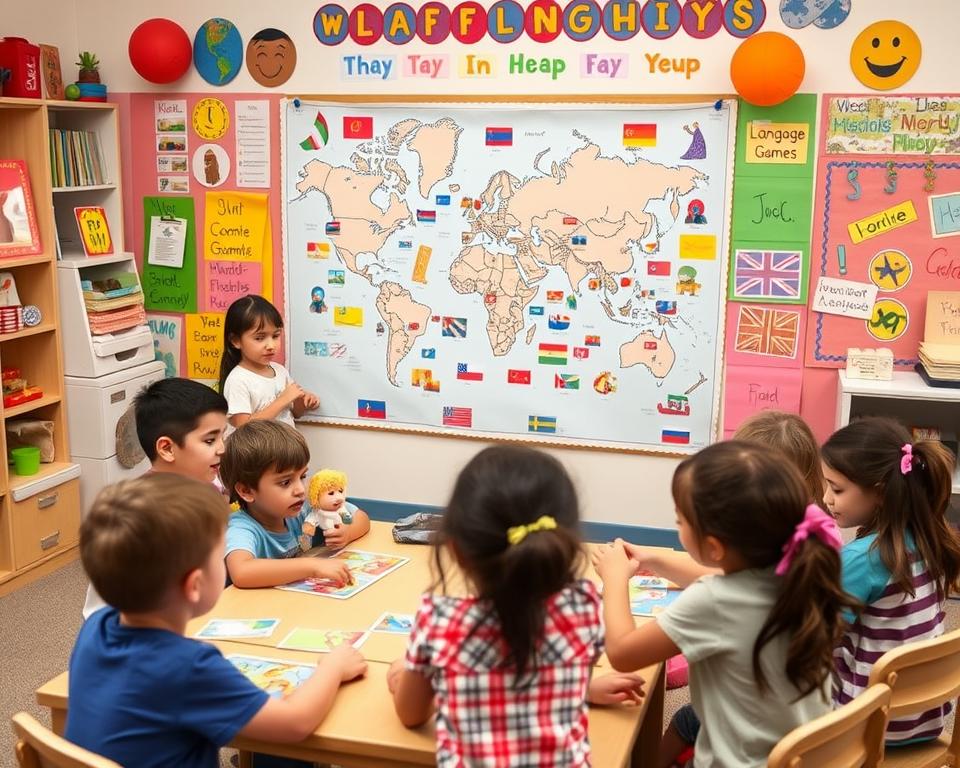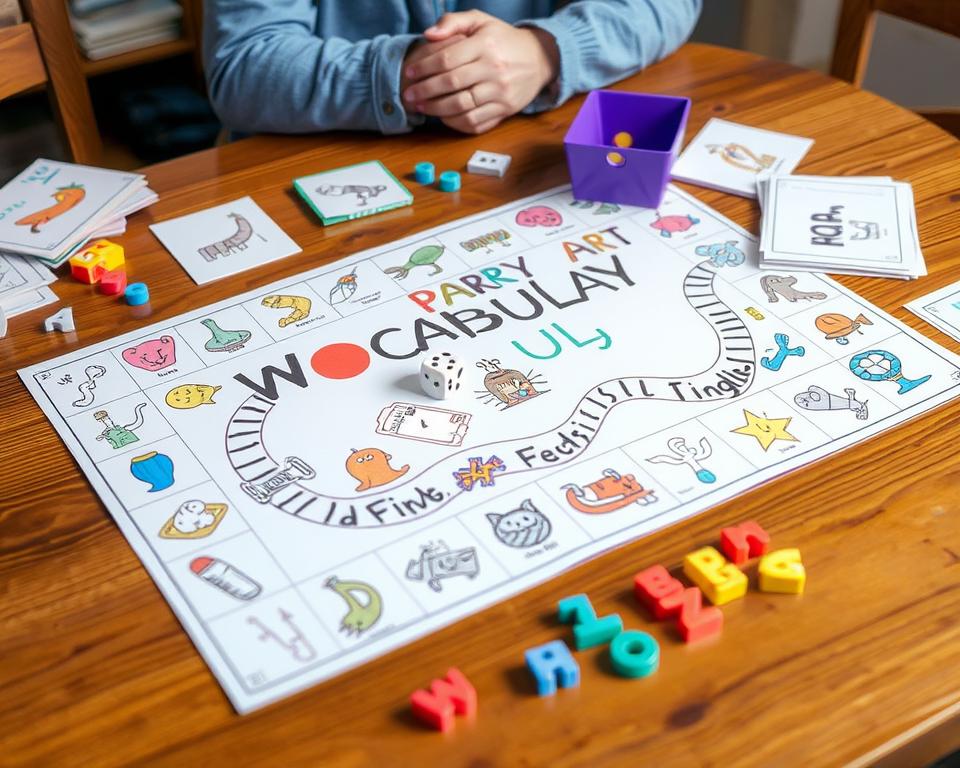Did you know 53% of kids benefit from learning languages early on? This shows how vital it is to make learning fun and engaging for them. In this guide, we’ll look at various language learning activities for kids that make learning languages enjoyable and help children develop their skills.
Learning a new language can seem tough, but it can also be thrilling. The secret to success is to use kids’ curiosity and love for learning. By adding games, interactive tools, and creative exercises, you can make learning a new language fun and exciting for your child.
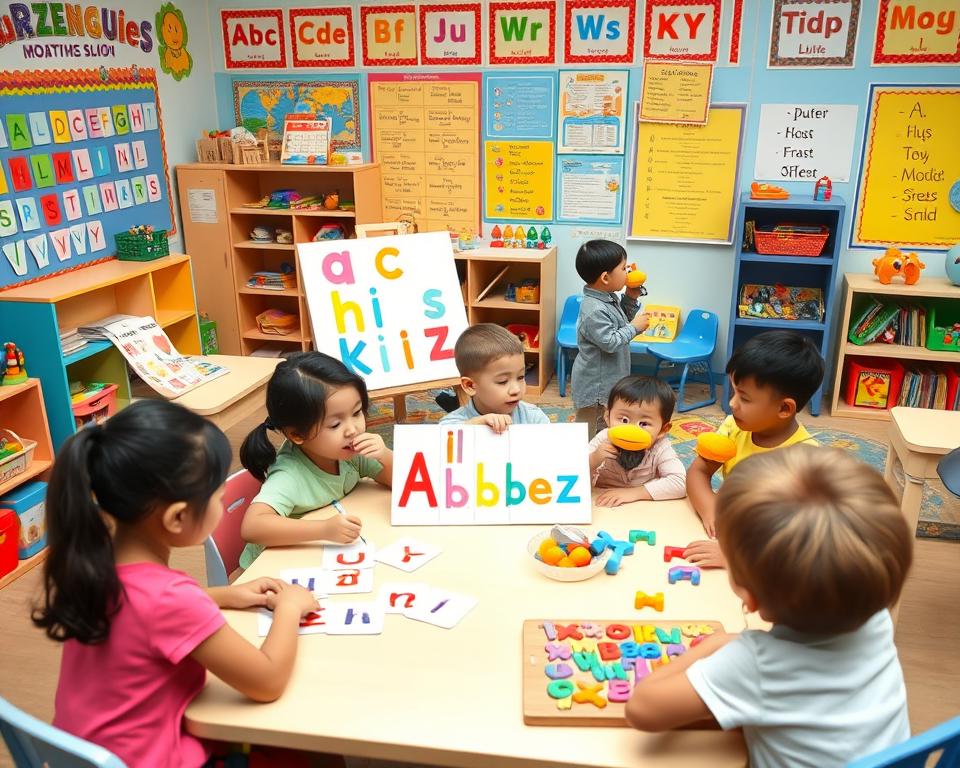
Why Making Language Learning Fun Matters for Children
Getting kids involved in language learning is key for their growth. Dr. Melissa Baese Berk, a linguistics professor at the University of Chicago, says motivation is essential. Fun activities boost a child’s motivation, leading to more practice and better results.
The Benefits of Playful Learning Approaches
Playful learning makes learning stick and keeps kids interested. Learning languages also boosts empathy and can slow down dementia.
Expert Insights on Children’s Language Development
Experts stress the need for fun in language learning for kids. Children have an edge in learning languages, and being multilingual can lead to higher earnings. It also opens their eyes to new cultures and ways of speaking.
“The majority of people on the planet are believed to be multilingual due to factors like colonialism and globalization.”
Making language learning fun can deeply impact a child’s language skills. It can spark a lifelong love for learning languages.
Interactive Games for Language Learning Activities for Kids
Learning a new language can be fun for kids with interactive games and activities. These language games for children help build vocabulary and improve speaking skills. They make learning a language fun and engaging.
Charades is a great game where kids act out words or phrases. It helps them understand language better. Bingo with language cards makes learning vocabulary exciting. Pictionary, where kids draw clues for words, boosts creativity and language practice.
- Language Jeopardy: Test knowledge of vocabulary, grammar, and sentence structure in a Jeopardy-style game.
- Hangman: Guess letters to reveal a hidden word, building spelling and word recognition skills.
- Bingo: Play with language-specific bingo cards to reinforce vocabulary and listening comprehension.
These interactive language exercises make learning fun and engaging. They encourage kids to participate, be creative, and communicate in the target language. Games in language learning create a dynamic and inspiring environment for kids to learn new languages.
“Games in primary education are important for improving focus, enhancing retention, and building problem-solving skills.”

Using language games for children and interactive language exercises in the classroom is very effective. They tap into kids’ natural curiosity and love for learning. This can help kids develop a lifelong love for language.
Classic Games Adapted for Language Learning
Using familiar games in language learning makes it fun and effective for kids. By changing classic games, teachers can use kids’ natural curiosity and love for play. This helps improve key language skills.
Charades and Pictionary for Vocabulary Building
Games like charades and pictionary are great for learning new words. Students act out or draw words, improving their understanding and speaking skills. These games help kids think creatively and learn new words in the target language.
Bingo and Memory Games in Multiple Languages
Bingo and memory games can include words from many languages. They help kids recognize and remember new vocabulary. These games are fun and make learning a team effort.
Spaceship Word Game Variations
The “Spaceship Word Game” can be changed to focus on different language skills. Players might have to spell words right, say them correctly, or use them in sentences. These versions make learning active, solve problems, and deepen language understanding.
By adding these classic games to language learning, teachers create a fun and engaging space. This space helps kids learn through play, making language acquisition exciting.
Digital Tools and Apps for Language Practice
In today’s world, learning languages for kids is more fun and easy than ever. Many interactive apps and online tools are changing how kids learn new languages. These tools make learning a game and offer chances to practice and get feedback right away.
For example, Duolingo has short lessons for kids of all ages. It uses points and fun exercises to make learning a game. Babbel focuses on talking and listening, which kids love.
Apps like Rosetta Stone Kids and Little Pim use cool visuals and games to teach language basics. They help kids learn words, how to say them, and grammar. These tools make learning a language fun and help kids build a strong foundation.
There are also many educational websites with language learning activities for kids. They have interactive maps, quizzes, flashcards, and more. These sites offer many languages, including rare ones, so kids can learn about the world’s languages.
Thanks to these digital tools, parents and teachers can easily add interactive language exercises to kids’ learning. This helps kids grow their language skills and think globally from a young age.
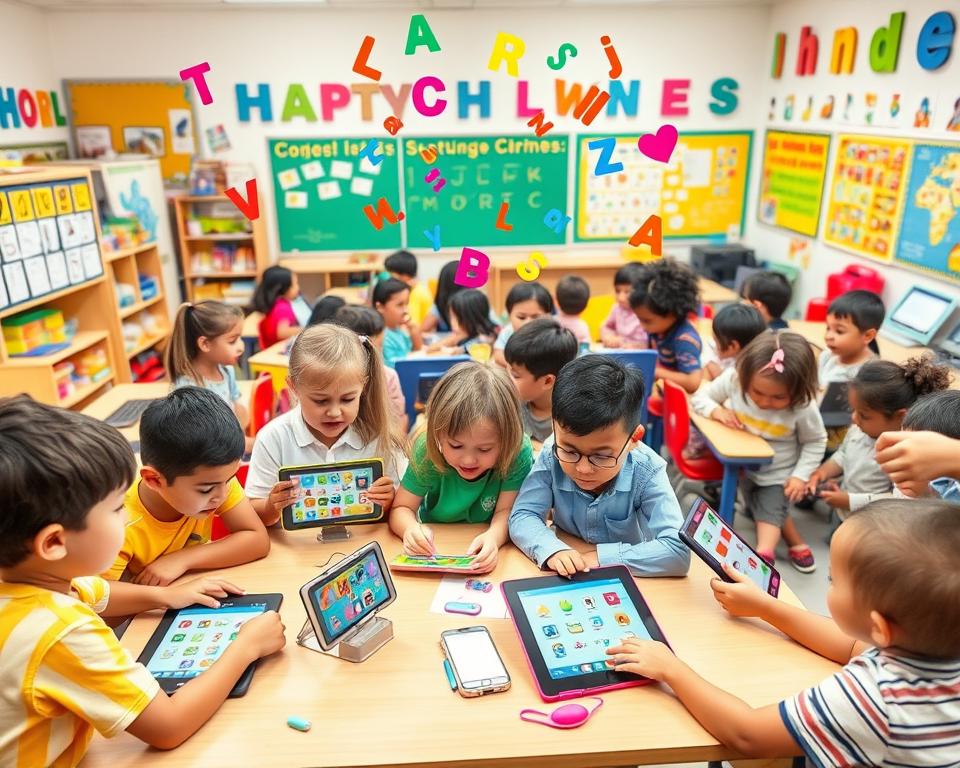
Music and Movement in Language Learning
Using music and movement in language learning can really help kids learn new words and skills. Songs and games make learning fun and help kids practice speaking and understanding different cultures.
Songs and Rhymes for Language Practice
Songs and rhymes in the target language help kids remember words and how to say them. Choose songs with simple lyrics and a good rhythm. This makes learning more fun and helps kids get better at speaking.
Dance Activities for Cultural Integration
Dance helps kids learn about different cultures and traditions. Games like “What’s the time, Mr Wolf?” and “Duck, Duck, Goose” are great for practicing language. They also help kids move and interact with others.
Musical Games for Pronunciation
Music games help kids improve how they say words. Songs and rhymes teach kids about syllables and stress. Writing their own songs helps kids be creative and remember words better.
“Music is a powerful tool for language development, helping children expand their vocabulary, improve pronunciation, and develop listening skills.”
Music and movement make learning a fun and engaging experience for kids. They help kids learn new languages, understand different cultures, and grow in many ways.
Creative Arts and Crafts for Language Development
Engaging kids in arts and crafts can boost their language skills. These activities let them explore language in a fun way. They help improve vocabulary, understanding, and speaking.
Activities like making flashcards or posters can help kids learn new words. They use materials like pom poms and markers to practice speaking. This helps them learn colors, form sentences, and work on speech sounds.
- Crafting with coffee filters, paper rolls, and cardstock can spark creativity while building language abilities.
- Incorporating stickers, paints, and other sensory elements makes the learning experience more engaging and memorable.
- For children with speech and language difficulties, such as expressive or receptive language disorders, these hands-on activities can be particularly beneficial.
Parents and teachers can use arts and crafts to support language goals. It makes learning fun and effective. This way, kids can enjoy learning new language skills.
“Over 90% of toucanBox subscribers confirmed that their children engage in arts and crafts more often since starting their subscription, and nearly 90% of parents mentioned that it encouraged them to participate more frequently.”
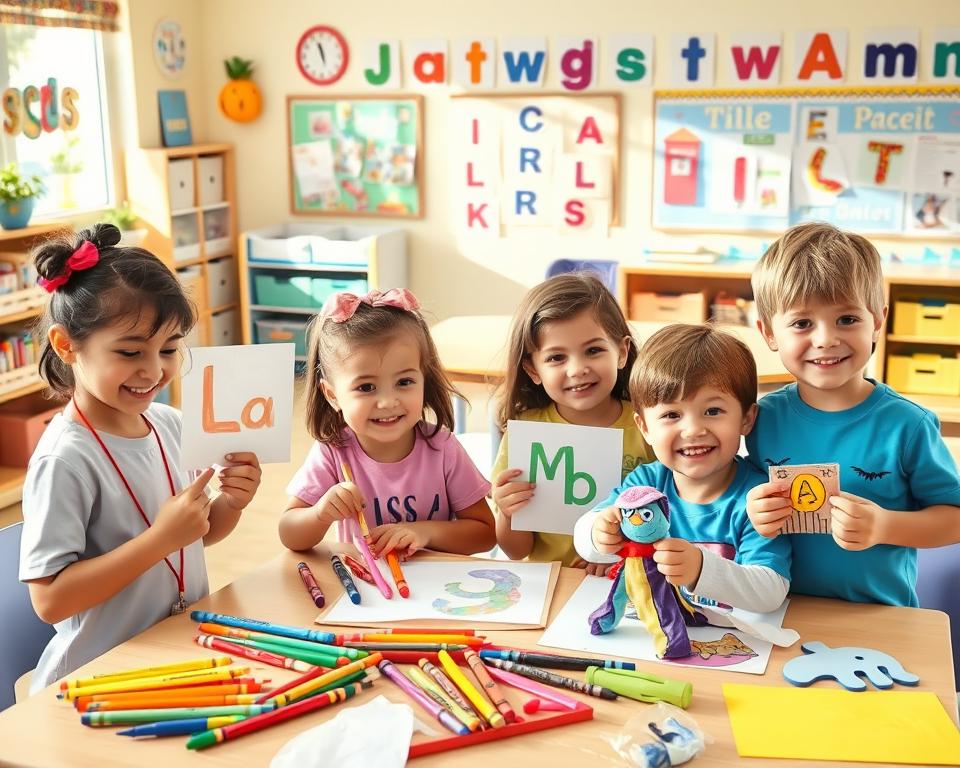
Parents and teachers can find resources for arts and crafts activities. These resources offer ideas for different ages and skill levels. Making language learning fun can help kids reach their full potential.
Immersive Reading and Storytelling Activities
Reading and storytelling are key for kids to learn languages. Bilingual books and comics help with vocabulary and grammar. Storytelling exercises make kids use the language more.
Reading games make texts fun to understand. They help kids see words in action and practice speaking.
Bilingual Books and Comics
Bilingual books and comics are great for language learning activities for kids. They let kids read in their own language and the new one. This helps build vocabulary and understand grammar better.
Comics add fun with their pictures. They make learning a language an enjoyable, interactive experience.
Story Creation Exercises
Storytelling exercises are another great way to learn a language. Kids can create new stories or change old ones. This boosts their confidence and fluency in the language.
Reading Comprehension Games
Reading games make learning a language fun. They help kids understand words in context and practice speaking. Tools like Microsoft’s Immersive Reader make reading even better with features like text-to-speech.
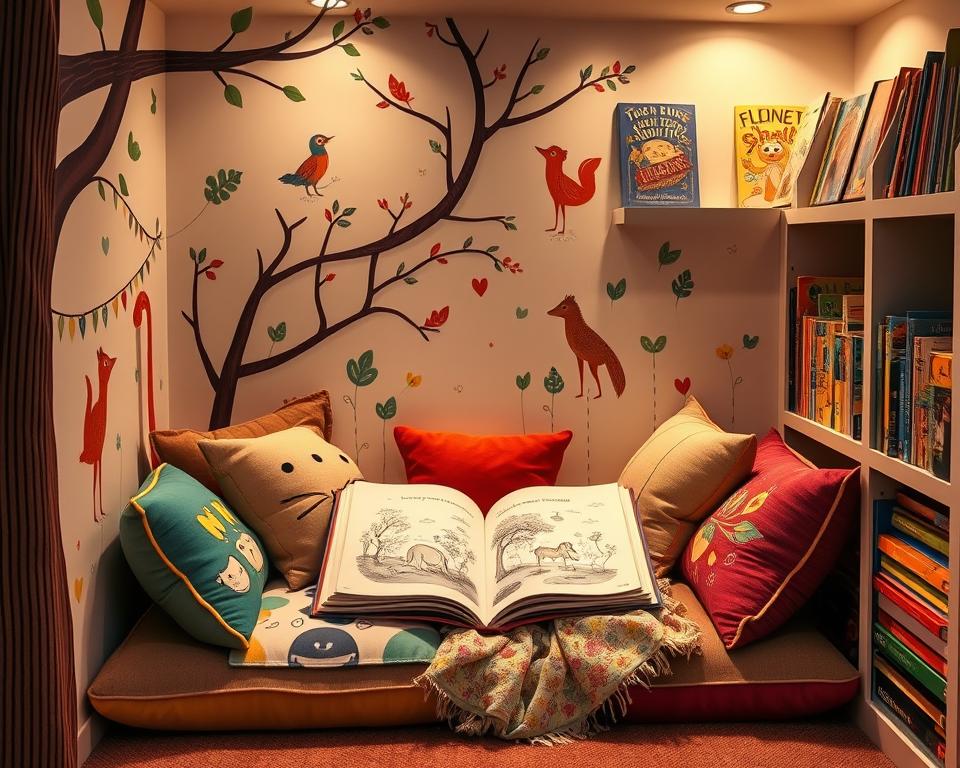
“Storytelling is a powerful tool for language learning, as it immerses children in meaningful contexts and encourages them to actively engage with the language.”
Cultural Learning Through Food and Cooking
Cooking is a fun way to learn about language and culture. Making dishes from different cultures teaches new words and insights. Kids learn about food, measurements, and cooking steps in the target language.
This hands-on method makes learning more fun and memorable. It uses many senses, helping kids remember better.
For instance, a 45-minute lesson on global food can introduce students to many cultures. They learn about the supply chain and how food is made and shared. They also discover the special meanings of traditional dishes.
For example, they might learn about the spiciness in Mexican food or the mildness in Andean dishes.
Teaching that respects students’ backgrounds helps them feel connected. Cooking together lets kids explore new foods and cooking ways. This builds their appreciation for different cultures and languages.

“Over 90% of a given culture is comprised of deep cultural values and beliefs that are not immediately visible.”
Using rich cultural resources, like the National Geographic Kids Encyclopedia of American Indian History & Culture or Dollar Street, offers deep insights. Food can help kids think critically, communicate better, and appreciate cultures.
Creating a welcoming space for students to share their food stories is key. This way, teachers can encourage cultural exchange and diversity. Learning through food and cooking is a great way to connect with different cultures and improve language skills.
Movie and Media-Based Language Activities
Movies and media are great for kids to learn a new language. They offer fun and interactive ways to learn. Subtitled films, video resources, and educational TV shows are all good for learning a language.
Using Subtitled Films for Learning
Watching subtitled films helps kids learn new words and improve speaking. Movies like “Life is Beautiful” (Italian) and “Amélie” (French) are good for learning. They have simple dialogue and clear speech.
Interactive Video Resources
Interactive videos and apps make learning fun and personal. They offer games and activities to help kids learn. These digital tools are great for immersive language learning for kids.
Educational TV Shows and Programs
Many TV shows are made for language learners. They mix fun with learning. These shows help kids improve listening, understand culture, and get better at speaking.
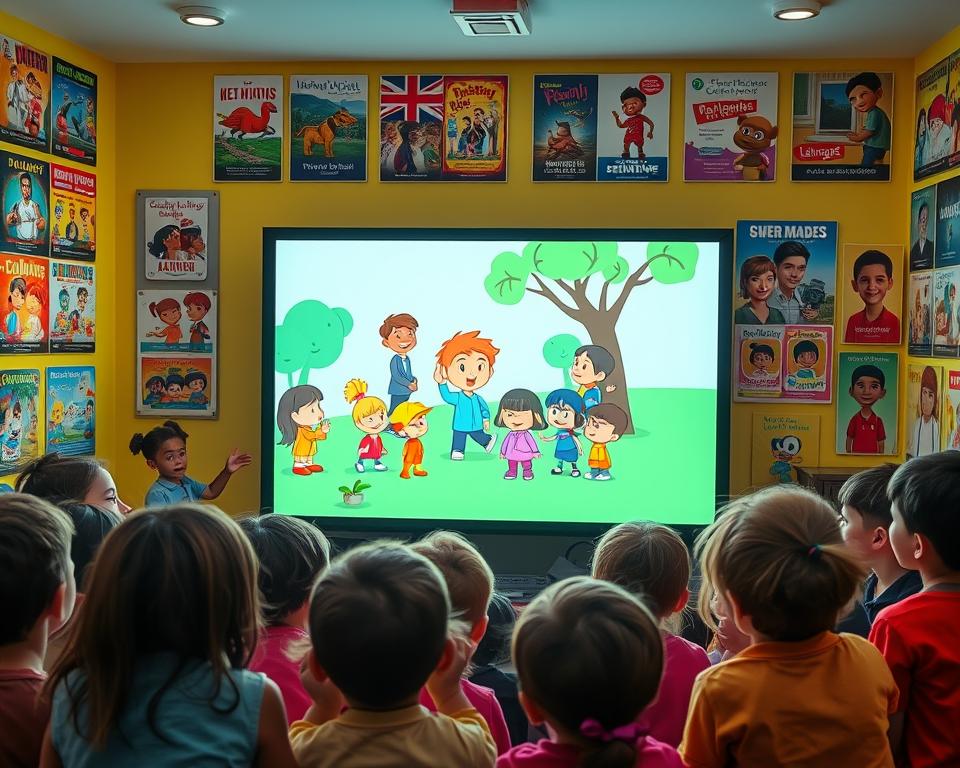
“Integrating films, shows, and interactive media into language learning can significantly enhance student motivation and make the process more enjoyable and effective.”
Social and Group Language Learning Games
Learning a new language is more fun with friends. Games that involve groups can really help kids learn. They can talk with native speakers or fans, which is great for practicing.
“Mad Libs” in the target language is a fun way for kids to learn about grammar and words. Board games like Scrabble in different languages and Kloo are made for language learners. They make learning a language a fun group activity.
- Apples to Apples Junior is for kids aged 9 and up. It’s a game that tests how well players can match nouns with adjectives.
- Guess Who? is for kids aged 6 and up. It’s a game where players ask questions to guess a hidden character.
- Blurt! is for kids aged 10 and up. It’s a game that tests how fast players can answer vocabulary questions.
- Bananagrams is for kids aged 7 and up. It’s a fast-paced game where players try to build crossword grids first.
These games help kids work together, think critically, and communicate better. They make learning a language fun and interactive.

The market for language learning games is growing fast. It’s expected to reach USD 6,117.05 million by 2029. This shows how much people want fun, interactive ways for kids to learn languages.
Writing and Journaling Activities
Getting kids to write and journal can really help them grow their language skills. By writing a little every day, they get to use new words and grammar. This makes them better at speaking and understanding the language.
Writing can be about anything, like what they did today or how they feel. For example, they might write about their favorite part of the day or a fun family trip. Writing about feelings and thoughts helps them learn and grow.
- Research shows that 52 journal prompts provided, one for each week of the year, can be effective for elementary school students.
- Journaling helps kids practice writing, remember important moments, feel better, and stay mentally healthy.
- Quick-writes, where students write for a set amount of time in response to a prompt or image, are a popular and effective activity for developing basic writing and grammar skills.
Journaling can also be part of other language activities, like reading or learning about different cultures. For example, kids might write about their favorite book characters or try new foods and traditions.
By making writing and journaling a part of learning a language, we can help kids love the language more. It helps them talk better, think clearly, and grow as people. Whether it’s daily writing or fun prompts, it’s a great way for kids to show what they know and feel.

“Journaling helps children build emotional expression, communication skills, self-awareness, and healthy self-esteem.”
Learning a new language is fun for kids when you mix different activities. Games, digital tools, cultural experiences, and creative exercises help. They match different learning styles and keep kids interested.
It’s important to make learning a new language an exciting journey. This sparks curiosity and keeps kids motivated. It helps them build strong language skills for life.
Teachers and parents can help kids love learning languages. They can use games, music, and stories to make it fun. This way, kids can explore and learn in a fun way.
Using many learning methods and making it fun helps kids become good at languages. They’ll do well in school and talk well with people from other countries. This is very important in today’s world.
20 Fun Language Learning Activities for Early Childhood (0-3 Years)
Here’s a list of 20 fun language learning activities designed for early childhood (0–3 years), focusing on engaging ways to nurture language development during these critical years:
1. Nursery Rhyme Time
- Sing classic nursery rhymes and songs. Repetition of words and melodies helps with vocabulary development.
2. Story Basket Play
- Fill a basket with simple objects (e.g., ball, spoon, toy car) and encourage the child to name them as they play.
3. Peek-a-Boo with Words
- Use peek-a-boo as a language game by introducing new words or sounds when you “reveal” yourself.
4. Action Songs
- Teach songs with movements (e.g., “Itsy Bitsy Spider”) to pair actions with words.
5. Talking Picture Books
- Use picture books to label and point out objects, animals, or people, encouraging your child to repeat the words.
6. Puppet Conversations
- Use puppets to “talk” with your child, encouraging turn-taking and interactive dialogue.
7. Label Everything
- Verbally label items around the room as the child interacts with them: “This is your cup. Here is the chair.”
8. Color Sorting with Vocabulary
- Use colored blocks or toys to sort by color while naming each one: “Red block, blue block.”
9. Sensory Play with Language
- Use sensory bins filled with rice, water, or sand to introduce descriptive words like “soft,” “wet,” or “cold.”
10. Mirror Talk
- Sit with your child in front of a mirror and talk about facial features: “Here’s your nose. Look, here are your eyes!”
11. Animal Sounds Game
- Introduce animals through sounds: “What does a cow say? Moo!” Let the child mimic the sounds.
12. Daily Chatter
- Narrate daily routines like dressing or eating: “Now we put on your socks. One sock, two socks!”
13. Hide-and-Seek with Toys
- Hide toys around the room and describe their location as the child searches: “The bear is under the table!”
14. Phone Chat
- Use a toy phone to role-play conversations, practicing phrases like “Hello! How are you?”
15. Fingerplay Rhymes
- Incorporate rhymes like “Where is Thumbkin?” to develop coordination and language together.
16. Sensory Word Matching
- Use tactile objects (soft fabric, hard blocks) and describe them: “This is soft; this is hard.”
17. “What’s in the Bag?”
- Fill a bag with familiar objects. Pull one out at a time and name it, encouraging the child to repeat.
18. Follow-the-Leader
- Engage in a movement game where you give simple verbal directions: “Clap your hands!” or “Wave!”
19. Bubble Blowing Descriptions
- Blow bubbles and describe actions: “Pop!” “The bubble is floating up!” “The bubble burst!”
20. Musical Word Play
- Use simple instruments like drums or shakers to create rhythm and chant new words or names.
These activities foster a strong language foundation through playful interactions, repetition, and engaging the senses, which are vital for early childhood language development.
20 Fun Language Learning Activities for Preschoolers (3-6 Years)
Here are 20 fun language learning activities for preschoolers (3–6 years) to enhance their vocabulary, comprehension, and communication skills through engaging play and exploration:
1. Alphabet Scavenger Hunt
- Hide letters or objects that start with specific letters around the room. Encourage children to find and name them.
2. Storytime Theater
- Act out favorite stories with props or costumes. Encourage children to retell parts of the story or create new endings.
3. Word Relay
- Write simple words on cards. Place them in a line, and as the child runs to each card, they read or say the word.
4. Rhyme Detective
- Say a word and challenge the child to find or say a word that rhymes with it. For example, “cat” -> “hat.”
5. I Spy with Words
- Use descriptive clues for the child to guess an object: “I spy something that is round and bounces.”
6. Picture Story Creation
- Use a series of pictures and have the child create a story by arranging them in a sequence and narrating what happens.
7. Opposite Matching
- Create a matching game with cards showing opposite words (e.g., big/small, hot/cold).
8. Name the Emotion
- Use pictures of faces showing different emotions and ask the child to describe how the person feels and why.
9. Puppet Show Conversations
- Let children use puppets to create dialogues, encouraging the use of new words and phrases.
10. Word Building with Blocks
- Use letter blocks to build simple words, encouraging phonetic awareness as they spell out what they see.
11. “Who Am I?” Guessing Game
- Give clues about a person, animal, or object, and have the child guess what it is. For example, “I have four legs and say woof.”
12. Word Sorting
- Sort objects, cards, or pictures into categories such as colors, shapes, or animals while naming and describing them.
13. Follow the Directions
- Give multi-step directions to complete a task: “Pick up the red block and put it in the basket, then clap your hands.”
14. Picture Book Storytelling
- Look at a picture book without reading the text and encourage the child to make up their own story based on the images.
15. Word Rhythms
- Create word patterns or rhymes using clapping or drumming. For example, “cat, hat, mat” with a clap for each word.
16. Mystery Bag Vocabulary
- Place objects in a bag. Have the child pull one out, name it, and describe its features or use.
17. Grocery Store Role-Play
- Set up a pretend store. Children can “shop” for items and describe them: “I’d like an apple, please.”
18. Alliteration Fun
- Create silly sentences where every word starts with the same letter: “Silly snakes slither slowly.”
19. Shadow Puppet Tales
- Use a flashlight and shadow puppets to tell a story. Encourage the child to narrate parts or describe characters.
20. Language Bingo
- Create bingo cards with pictures or words. Call out a word, and the child covers the matching square.
These activities combine creativity, critical thinking, and play to make language learning interactive and enjoyable for preschoolers, setting the foundation for strong communication skills.
20 Fun Language Learning Activities for Primary School Age (6-10 Years)
Here are 20 fun language learning activities tailored for primary school-aged children (6–10 years), aimed at expanding their vocabulary, grammar, and language skills while keeping them engaged:
1. Vocabulary Treasure Hunt
- Hide word cards around the room. As children find them, they must use the words in sentences or match them to definitions.
2. Story Chain
- Start a story with one sentence, and have children take turns adding to it. This builds creativity and language fluency.
3. Word Jumble Race
- Scramble letters of words on cards. Children race to unscramble them and form sentences with the words.
4. Language Board Games
- Use games like Scrabble, Boggle, or custom-made word puzzles to build vocabulary and spelling skills.
5. Comic Strip Creations
- Have children draw and write their own comic strips, focusing on dialogue and sequencing.
6. Word Association Game
- Say a word, and the child responds with a related word. For example, you say “sun,” and they say “hot.”
7. Tongue Twister Challenge
- Introduce tongue twisters to practice pronunciation and have fun with tricky sounds.
8. Sentence Scramble
- Write a sentence, cut the words apart, and have children rearrange them in the correct order.
9. Rhyme Time Relay
- Divide into teams. Give a word, and each team takes turns coming up with rhymes. The team with the most wins.
10. Synonym Swap
- Write sentences with key words underlined. Challenge children to replace the underlined word with a synonym.
11. Picture Prompt Stories
- Show an interesting picture and ask children to write a short story inspired by it.
12. Act It Out
- Write phrases or short sentences on cards. Children act them out while others guess the action or emotion.
13. Word of the Day Challenge
- Introduce a new word daily and encourage children to use it in as many ways as possible during the day.
14. Language Detective
- Create clues leading to hidden objects. Each clue contains a riddle or phrase to decode.
15. Grammar Ball Toss
- Toss a ball to a child and say a word. They respond with the plural, past tense, or a sentence using it.
16. Mad Libs Fun
- Use Mad Libs to teach parts of speech while creating silly stories that make kids laugh.
17. Reading Theater
- Assign roles from a short play or dialogue and have children practice expressive reading.
18. “I Am Thinking of a Word…”
- Give hints for a mystery word: “It’s an animal. It has stripes. It starts with a Z.” Answer: Zebra.
19. Foreign Language Bingo
- For bilingual learners, create bingo cards with words in another language. Call out translations, and they find the matches.
20. Word Creation Challenge
- Provide a list of root words and prefixes/suffixes. Children create as many words as possible and use them in sentences.
These activities engage primary school-aged children in a variety of ways, from creative storytelling to interactive games, making language learning a fun and immersive experience.
20 Fun Language Learning Activities for Adolescence (10+ Years)
Here are 20 fun language learning activities tailored for adolescents (10+ years). These activities promote critical thinking, creativity, and collaboration while keeping language learning engaging:
1. Debate Club
- Choose fun or thought-provoking topics and hold debates, encouraging students to practice persuasive language and reasoning skills.
2. Story Rewriting
- Take a well-known story and rewrite it from another character’s perspective or in a different setting.
3. Language Escape Room
- Create puzzles, riddles, or tasks that require language skills to unlock clues and “escape” a room.
4. Digital Storytelling
- Use apps or tools to create short digital stories or videos with scripts written in the target language.
5. Vocabulary Scavenger Hunt
- Create a scavenger hunt with clues written in riddles or descriptions that require decoding and vocabulary knowledge.
6. Song Lyric Analysis
- Analyze and discuss lyrics from popular songs, focusing on vocabulary, metaphors, and cultural context.
7. Mystery Role-Play
- Assign roles and create a mystery for the group to solve. They must ask questions, give clues, and explain their reasoning.
8. Language Podcasts
- Record a podcast where students discuss their favorite topics, interview each other, or review books and movies.
9. Creative Journal Writing
- Encourage journaling with prompts like “What superpower would you want and why?” or “Describe your perfect day.”
10. News Report Simulation
- Have students create and present mock news reports, using formal language and storytelling techniques.
11. “Two Truths and a Lie”
- Students share two true statements and one lie about themselves. Others guess which is the lie, using reasoning and questioning skills.
12. Film Scene Dub
- Mute a scene from a movie and have students dub their own dialogue, focusing on creativity and expression.
13. Language Board Game Design
- Have students create their own board games that incorporate vocabulary, grammar, or storytelling challenges.
14. Social Media Post Creation
- Create pretend social media posts, captions, or hashtags about specific themes, practicing concise and creative language use.
15. Writing Letters or Emails
- Practice formal and informal writing by drafting letters to pen pals, imaginary characters, or historical figures.
16. Book Club Discussions
- Read and discuss short stories, novels, or graphic novels, focusing on themes, character development, and new vocabulary.
17. Picture Prompt Challenges
- Use abstract or interesting pictures to inspire descriptive writing, dialogues, or short stories.
18. Word Guessing Games
- Play games like Taboo or 20 Questions to practice descriptions and asking questions in the target language.
19. Language Charades
- Act out phrases, idioms, or words for others to guess, encouraging active vocabulary recall.
20. Cultural Cuisine Day
- Research and present recipes from a country where the target language is spoken. Practice reading, translating, and presenting instructions.
These activities cater to the developmental stage and interests of adolescents, combining fun, creativity, and real-world application to foster a deeper connection with language learning.
Key Takeaways
- Motivation is key in language learning, with motivated learners often practicing more and learning more.
- Games and interactive activities can boost vocabulary retention by up to 35% compared to traditional methods.
- Tailored games like Kloo offer engaging and immersive learning experiences for kids.
- Hands-on activities, such as speaking and spelling games, make up 3 out of 5 language learning experiences for kids.
- Connecting with foreign friends or pen pals is valuable, with 48% of kids participating in this activity.
Source Links
- 16 Language Learning Games & Activities: Fun & Effective – https://preply.com/en/blog/at-home-language-learning-games/
- 5 Language Learning Games and Activities for All Ages – https://blog.peps.org/2022/09/20/5-language-learning-games-and-activities-for-all-ages/
- 6 reasons why language learning is important for children ‹ GO Blog | EF United States – https://www.ef.edu/blog/language/6-reasons-why-language-learning-is-important-for-children/
- How to Make Language Learning Fun for Kids | Rayito de Sol – https://www.rayitoschools.com/blog/how-to-make-language-learning-fun-for-your-kids/
- Teacher’s Corner: Making Learning Fun – https://americanenglish.state.gov/resources/teachers-corner-making-learning-fun
- Kids Language Learning Fun – https://www.childrenslearningadventure.com/index.php/blog/kids-language-learning-fun
- Six great language learning games to try in your classroom – https://sanako.com/six-great-language-learning-games-to-try-in-your-classroom
- Games for Learning English, Vocabulary, Grammar Games, Activities, ESL – https://www.eslgamesplus.com/
- 10 Fun ESL Games and Activities for Teaching Kids English Abroad – https://www.gooverseas.com/blog/10-best-games-esl-teachers
- 17 Fun Games to Get World Language Learners Talking – https://www.edutopia.org/article/17-fun-games-to-get-world-language-learners-talking/
- ESL Games and Activities for Kids & Teens – https://bridge.edu/tefl/blog/esl-games-activities-kids-young-learners/
- 10 Best Language Learning Apps For Kids – https://elearningindustry.com/10-best-language-learning-apps-for-kids
- Language learning games & activities – https://www.digitaldialects.com/
- Language Learning for Kids – Dinolingo | Best Language Learning App for Kids – https://www.dinolingo.com/?srsltid=AfmBOoozFwevOBFclCUoelRWnBeH4Cka1Ur178CzPZ0KVRuLdm9youP1
- Teaching young learners: How to use music and movement in the classroom – https://www.onestopenglish.com/topics-and-themes/teaching-young-learners-how-to-use-music-and-movement-in-the-classroom/556552.article
- Music and Movement for Preschoolers | XIHA Montessori – https://xihamontessori.com/music-and-movement-for-preschoolers/
- 7 Craft Ideas for Practicing Speech and Language at Home – https://www.expressable.com/learning-center/tips-and-resources/7-craft-ideas-for-practicing-speech-and-language-at-home
- Language development through arts and crafts | toucanbox – https://www.toucanbox.com/insights/language-development-through-arts-crafts
- The power of Immersive Reader in the classroom with Flocabulary – https://blog.flocabulary.com/immersive-reader/
- A Mini-Crash-Course on Oral Storytelling – https://twowritingteachers.org/2014/04/06/a-mini-crash-course-on-oral-storytelling/
- Storytelling, Immersion and SEN – Creating a love of stories – https://inclusiveteach.com/2015/08/18/storytelling-immersion-and-sen/
- Cultures, Food, and Communities Around the World (Grades K-2) – https://agclassroom.org/matrix/lesson/828/
- How To Use Food To Teach About Culture in a Meaningful Way – We Are Teachers – https://www.weareteachers.com/teaching-food-and-culture/
- Using Food to Introduce Children to New Cultures – San-J – https://san-j.com/blog/using-food-to-introduce-children-to-new-cultures/
- Using Film and Media to Teach English – https://eflcafe.net/using-film-and-media-to-teach-english/
- Adaptive Media Activities for Every Classroom – https://ellii.com/blog/adaptive-media-activities-for-every-classroom
- Movie Talk – Love Language – https://creativeaslteaching.com/movie-talk-love-language/
- 8 Board Games That Teach Social & Language Skills – The Clubhouse – https://www.communicationclubhouse.com/blog/8-board-games-that-teach-social-and-language-skills/
- 12 Fun Language Learning Games to Play with Friends – https://lingopie.com/blog/10-fun-language-learning-games-to-play-with-friends/
- 20 Best Language and Literacy Activities for Preschoolers – https://blog.acceleratelearning.com/20-best-language-and-literacy-activities-for-preschoolers
- 52 Journal Prompts for Kids to Practice Writing – Waterford.org – https://www.waterford.org/blog/journal-prompts-for-kids/
- Quick-Writes – Easy Journal Activities – https://traciclausen.com/2013/09/quick-writes-and-peek-at-my-week.html
- Encourage Journaling for Kids Ages 4–14 – https://www.scholastic.com/parents/books-and-reading/raise-a-reader-blog/how-journaling-benefits-your-child.html
- Supporting English Language Learners – https://kindergartencafe.org/supporting-students-to-learn-english/
- Classroom activities that encourage kids to speak English – https://teflhandbook.com/blog/classroom-activities/esl-activity-ideas-kids-speaking/

